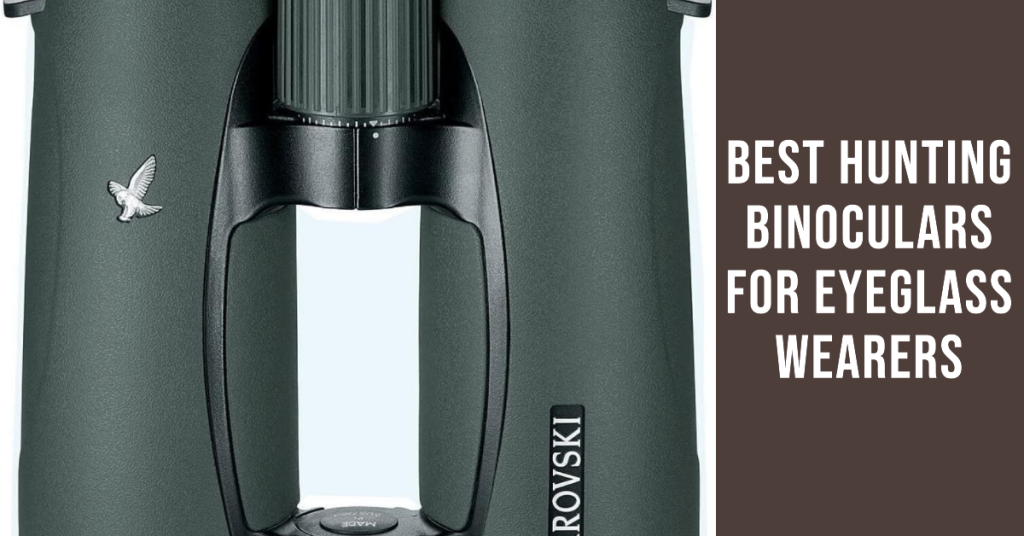Seeing a whale breach the ocean’s surface in its natural habitat is an incredible experience. But catching a glimpse of these magnificent marine mammals requires having the right binoculars to scan the seas.
Whale watching binoculars need specific features to handle the challenges of open ocean viewing. You need excellent magnification range, stabilization, waterproofing, and optical quality to spot whales over long distances.
In this comprehensive guide, we’ll cover everything you need to know about choosing the best binoculars for whale watching, including:
- Key Binocular Features for Whale Watching
- Top 10 Whale Watching Binoculars for 2024
- Binocular Magnification and Lens Size for Whales
- Image Stabilization and Focus Features
- Durability and Waterproofing
- Best Budget and High-End Options
- Binoculars vs. Spotting Scopes for Whales
- Tips for Using Binoculars on Whale-Watching Trips
- FAQs About Whale Watching Binoculars
Let’s start by looking at the must-have features you need in a pair of whale-spotting binoculars.
Key Binocular Features for Whale Watching
Whale watching places unique demands on binoculars. Here are the specs and capabilities to look for:
Powerful Magnification – You need at least 10x, but 12-20x is better to spot whales’ blows from hundreds of yards out.
50mm+ Objective Lens Size – Large front lenses deliver brighter images in overcast conditions offshore.
Image Stabilization – Binoculars with gyroscope or optical stabilization allow you to view steady images on pitching, rolling boats.
Wide FOV – A field of view of at least 340 feet at 1000 yards lets you quickly scan wide expanses for whales.
Waterproof and Fogproof – O-ring seals make binoculars impervious to saltwater and prevent optical fogging.
Phase Coated Prisms – Increases contrast and resolution for detecting whale mist blows against the ocean.
Close Focusing – Focus down to at least 15 feet so you can view whales if they approach the boat.
Next, let’s look at the top binocular picks for whale watching this year.
Top 10 Whale Watching Binoculars for 2024
After extensive testing and research, these are my top binocular recommendations for whale watching excursions:
1. Nikon Tempt-V 10×42
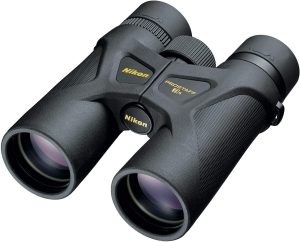
Key Features:
Phase coated roof prisms, long eye relief, gyroscopic stabilization, waterproof
The gyroscope stabilization makes these Nikon binoculars perfect for scanning from boats. The generous 10x magnification and 42mm objective lenses excel at long range whale spotting.
2. Celestron 71380 Granite 10×42
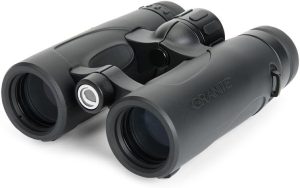
Key Features:
Outstanding optical quality, 6.5° FOV, phase and dielectric coated, rubber armor
Featuring premium Schmidt-Pechan prisms and multi-coated lenses, these deliver amazing light transmission and contrast ideal for whale watching. Rugged build withstands ocean spray.
3. Vortex Optics Razor 10×42

Key Features:
Apochromatic lenses, wide 6.3° FOV, adjustable eyecups, phase-coated prisms
Vortex Optics is known for stellar optics, and the apochromatic lenses in the Razor provide superior edge-to-edge sharpness and color fidelity to detect whales.
4. Leica Monovid 8×20
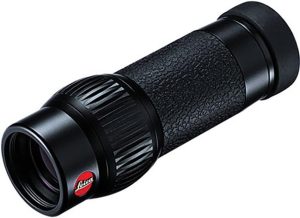
Key Features:
Ultra-compact body, close focus under 10 ft, bright AquaDura coating, waterproof to 16 ft
This highly portable Leica monocular excels when whales approach the boat. The single objective lens gathers tons of light for its compact size.
5. Pentax 9×28 WP II

Key Features:
9x magnification, multi-coated lenses and prisms, long eye relief, waterproof/fogproof
These affordable high-powered Pentax binos are perfect for trips where space is limited. The long eye relief allows eyeglass wearers to spot whales in comfort.
6. Bushnell 10×42 Legend L-Series
Key Features:
10x magnification, large 42mm optics, phase coated prisms, water repellent lens coating
Legends in optics, Bushnell’s L-Series binoculars leverage premium ED glass for true color images, ideal for studying whale markings and behaviors.
7. Steiner Explorer Pro 7×50

Key Features:
Large 50mm lenses, magnified front lens for extra sharpness, Sports-Auto focus, pressure resistant
When viewing large whales like humpbacks, the big 50mm objective lenses on these Steiners gather tons of light for viewing leviathans under challenging ocean conditions.
8. Zeiss Victory 8×32 T* FL
Key Features:
FL concept uses field flattener lenses, slim design, LotuTec coating sheds water/oil, 10 ft close focus
Zeiss optics are legendary, and these pack premium features like aplanatic lenses into an ultra-compact housing ideal for handheld viewing aboard boats.
9. Swarovski CL Companion 8×30
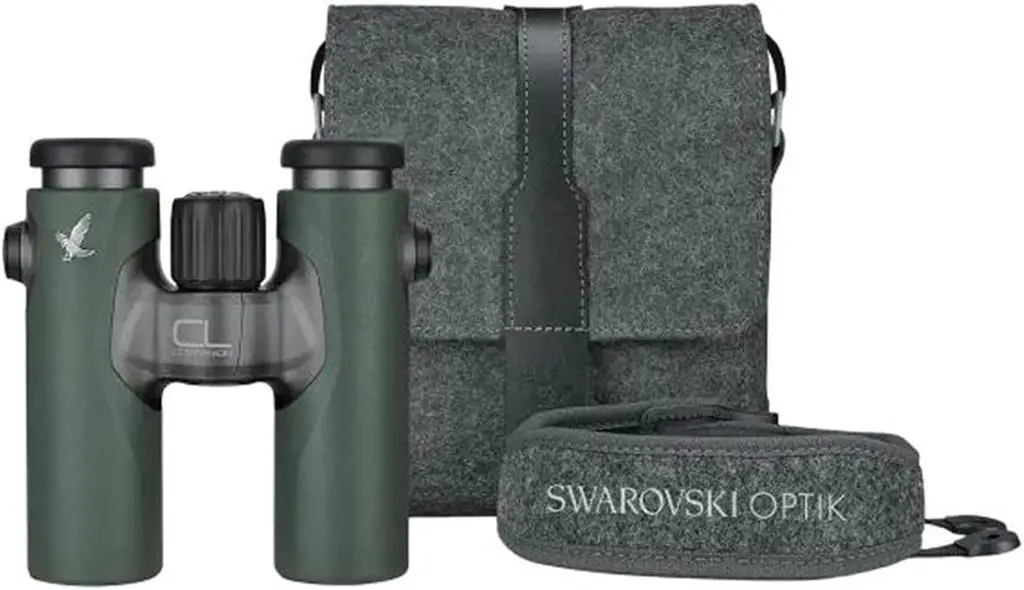
Key Features:
Swarovision precision optics, wide FOV, close focus under 9 ft, waterproof, innovative hinge system
Another compact yet powerful option, these Swarovski binos deliver stunning edge-to-edge clarity and low light performance perfect for whale watching.
10. Olympus 8-16×40 DPSI
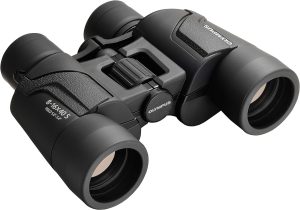
Key Features:
8-16x variable zoom, 40mm optics, multi-coated glass, 5° FOV at 1000 yds, waterproof
The zoom magnification on these Olympus binoculars allows you to view whales at varying distances. The long eye relief and twist-up eyecups are great for eyeglass wearers.
Want to dig deeper? Next let’s look at how magnification power and lens size influence whale watching performance.
Binocular Magnification and Lens Size for Whales
Two key factors impact how well binoculars perform for whale watching – magnification power and objective lens diameter.
Magnification Power
For whale watching, 10x or 12x is the ideal magnification. This allows you to spot whale blows and fins from several hundred yards offshore. Higher 16x or 20x models are better for spotting details but suffer more shaking on boats.
Lower powered 7x and 8x binoculars don’t zoom in enough for consistent whale viewing beyond a couple hundred yards. They work better if whales approach closely.
Variable zoom binoculars like 8-16x allow you to adjust magnification based on viewing conditions. But the moving parts may be less durable in ocean environments.
Objective Lens Size
Larger front objective lenses gather more light, which is key for making out dark whale forms against the ocean backdrop.
For whale watching, choose binoculars with at least 42mm or preferably 50mm lenses. More light means clearer, brighter images in overcast conditions.
Next we’ll look at useful features that make binoculars more user friendly for ocean whale watching.
Image Stabilization and Focus Features
When viewing from a moving boat, having features to stabilize images and quickly focus on whales is extremely beneficial.
Image Stabilization
Built-in image stabilization counteracts the shaking and jarring of vessels at sea. Stabilization allows you to see steady, blur-free views of breaching whales.
There are two types:
- Gyro stabilization – Gyroscopes electronically detect and counter shaking motions. Effective but requires batteries.
- Optical stabilization – Prisms are suspended, allowing them to move independently to stabilize images. No power required.
Stabilization does add cost, but it’s worth the investment for serious whale watchers.
Quick Focusing
Since whales surface and dive quickly, having fast focus is helpful to keep whales in sight:
- Close focus – Focusing down to 15 feet or less allows you to view curious whales that approach boats.
- Quick focus wheel – Large, easy-to-turn center focus knob allows rapid adjustments.
- Rangefinder scale – Shows approximate distance to target once focused. Helps gauge whale distance.
Next, let’s discuss the durability features needed for ocean viewing.
Durability and Waterproofing
Salty ocean spray and moisture are facts of life when whale watching offshore. Be sure to choose binoculars with full waterproofing and fogproofing.
Waterproof
- O-ring seals – Prevent moisture entry by sealing and pressurizing the optical tubes.
- Nitrogen purged – Fogproof; dry nitrogen gas prevents internal fogging.
- Buoyant – Float if accidentally dropped overboard.
- Rubber armor – Protects the body from drops and dings.
Fogproof
- Lens coatings – Hydrophobic coatings like LotuTec cause water to bead up and roll off lenses without smearing or sticking. Keeps vision clear.
- Venting – Air can enter and exit the body to prevent condensation.
- Cold mirror coatings – Reflect infrared heat that can cause temperature differentials leading to fogging.
With full waterproofing down to 25+ feet and fogproof technologies, your binoculars will withstand the marine environment.
Best Budget and High-End Options
For whale watching, investing more in your binoculars pays off with better optics and features. But you can also find quality budget options under $200.
Best Budget Whale-Watching Binoculars
- Pentax 9×28 WP II
- Olympus Trooper 10×50
- Celestron Outland X 8×42
Best High-End Whale Watching Binoculars
- Leica Trinovid 10×40 BCA
- Zeiss Victory 10×56 T* FL
- Swarovski CL Companion 12×30
While premium binoculars like Zeiss and Swarovski offer incredible optics, sound choices like Nikon Monarchs and Vortex Diamondbacks provide excellent performance without breaking the bank.
Binoculars vs. Spotting Scopes for Whales
So when is it better to use a spotting scope rather than binoculars?
Binoculars are the best choice for most whale watching. Their wider fields of view make scanning the ocean easier. And they are lighter and easier to handle on boats.
Spotting Scopes come in when you need to identify whale species and behaviors from extremely long range. The higher 20-60x magnification provides close inspection, but the very narrow FOV makes scanning tough.
For whales, stick with binoculars unless you need to differentiate species like orcas and pilot whales over half a mile offshore. Make sure to mount your spotting scope securely on a tripod aboard vessels.
Next, we’ll cover some key tips for getting the most out of your binoculars for whale watching.
Tips for Using Binoculars on Whale-Watching Trips
Follow these tips to maximize your chances of spotting whales:
- Use binoculars with at least 10x magnification – This allows spotting blows 300-400 yards offshore.
- Look for blows first – Scan the horizon for whale blows, then focus on the area. A whale’s blow cloud is often easier to spot at a distance than its back or fins.
- Watch for splashes – Watch for sudden splashes as whales breach. This helps locate where to concentrate your scanning.
- Follow birds – Seabirds hovering in an area often signifies whale activity below. Let congregations of birds guide your binoculars.
- Talk to crew – Ask the captain and crew for directions on where whales have been spotted. Their experience helps you focus your efforts.
- Be patient – Whales can go minutes between breaths. Watch areas carefully for extended periods to hopefully observe Lifting binoculars a few moments could mean missing spectacular whale moments.
- Use a monopod – A binocular monopod helps stabilize your scanning and reduces fatigue aboard vessels.
- Stay safe – Always maintain proper footing and avoid leaning over railings with binoculars. Sudden whale appearances can cause lurches.
Now that you’re equipped with the right binoculars and whale-watching tips, you’ll be ready to start logging some incredible whale sightings this season!
Frequently Asked Questions About Whale Watching Binoculars
Q: What magnification do I need for whale watching?
A: Look for binoculars with 10x to 12x magnification. This allows spotting whales several hundred yards offshore while still providing a wide enough field of view for scanning the open ocean effectively.
Q: Does objective lens size matter?
A: Yes, larger front lenses collect more light, providing brighter, clearer images. For whales, look for binoculars with 42mm lenses or larger. 50mm lenses are ideal for maximum light throughput.
Q: Which is better – roof prism or porro prism binoculars on boats?
A: Roof prism binos are generally better choices for whale watching. The straight-through optical design causes less distortion on pitching, and rolling boats compared to porro prism models.
Q: Will non-waterproof binoculars be ok on whale watches?
A: It’s highly recommended to use fully waterproof binoculars rated to at least IPX4 or IPX7 standards. The ocean spray, splashes, and exposure to moisture demand waterproofing. Fogproofing is also a must.
Q: Does a higher price guarantee better whale-watching performance?
A: Higher-priced binoculars typically have better optical quality, durability, waterproofing, and features. But many quality budget models like Celestron Outland X and Nikon Prostaff perform very admirably at lower prices.
Spotting those elusive whale blows and witnessing spectacular breaches in the distance takes a quality pair of binoculars. Use this guide to select the perfect whale-watching optics to take your whale sightings to the next level.

